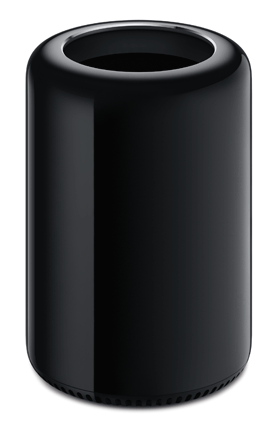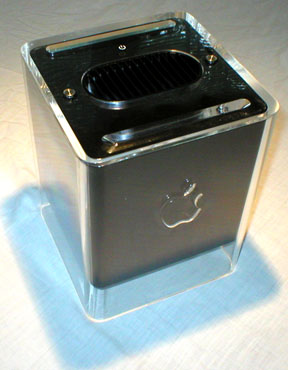New Mac Pro "Cylinder" rises from the Cube's Ashes?
by Bill Fox, MacsOnly.com June 20, 2013
 Tim Cook fittingly announced Apple's new Mac Pro at Apple's WWDC last week (at right, courtesy of Apple, Inc.). Later this year it will take it's place as the latest in the line of large beige or translucent plastic-cased or silver aluminum-cased core Apple computers. The new Mac Pro is a very cool machined aluminum cylinder in black that stands under 10" high and under 7" in diameter, just one-ninth the volume of the huge Mac Pro it replaces according to Apple. With an appropriate cradle, it will look like a beautiful mini-sized Cray super-computer. Tim Cook fittingly announced Apple's new Mac Pro at Apple's WWDC last week (at right, courtesy of Apple, Inc.). Later this year it will take it's place as the latest in the line of large beige or translucent plastic-cased or silver aluminum-cased core Apple computers. The new Mac Pro is a very cool machined aluminum cylinder in black that stands under 10" high and under 7" in diameter, just one-ninth the volume of the huge Mac Pro it replaces according to Apple. With an appropriate cradle, it will look like a beautiful mini-sized Cray super-computer.
Technologically, the new Mac Pro will be a top shelf exposure of Apple's design and engineering. It will sport the latest Intel workstation CPU (aka Haswell) with up to 12 cores, up to 128GB of fast four-channel DDR3 1866 MHz error correcting RAM, and the fastest PCI Express 3.0 solid state storage. The graphics will be provided by a pair of AMD FirePro workstation-class graphics cards with 6GB of VRAM. All of this will be arranged as a triangle inside of the cylinder with a specially-designed fan at the top to draw heat up out of the core much faster than heat normally rises but perhaps nearly as quietly. Expansion is via 4 USB 3.0, 6 Thunderbolt 2, 1 HDMI and 2 gigabit ethernet ports. Wireless connections are through three-stream 802.11ac WiFi and Bluetooth 4.0.
That is all we know about the new Mac Pro at this point...but wait, haven't we seen something like this from Apple before?
How about the PowerMac G4 Cube?
 I can hear Apple's marketing people groaning over any comparison with the Cube because it was a commercial failure, one of Apple's very few failures. But, hey, I am Cube lover and proud of it. I was one of the first to get one in August 2000 and one of the first to become dejected after Apple suspended its production in 2001 following a series of marketing and technical goofs that killed its sales. I now have two and enough parts to build a third. One is completely stock and the other I have modified over the years to keep it as up to date as possible--I even painted the case of my upgraded Super Cube black as shown at right. I can hear Apple's marketing people groaning over any comparison with the Cube because it was a commercial failure, one of Apple's very few failures. But, hey, I am Cube lover and proud of it. I was one of the first to get one in August 2000 and one of the first to become dejected after Apple suspended its production in 2001 following a series of marketing and technical goofs that killed its sales. I now have two and enough parts to build a third. One is completely stock and the other I have modified over the years to keep it as up to date as possible--I even painted the case of my upgraded Super Cube black as shown at right.
The PowerMac G4 Cube is roughly the same size as the new Mac Pro "Cylinder". It's just under 10" high but an inch or so wider at just under 8". The Cube was billed as an 8" cube but it had a 2" "stand" through the extension of the sides of its clear case. It's internals were also built around an internal heat core but with 4 sides rather than the 3 in the "Cylinder". One difference is the Cube came without a fan initially but us enthusiasts added a slow quiet fan when upgrading the Cube's CPU and graphics card. The ability to upgrade the CPU and graphics cards may also be a difference but we'll have to wait and see on that.
The Cube, like the "Cylinder", also relies on external expansion for additional storage or functionality but through much slower USB 2.0, FireWire 400 and 10/100 ethernet, the fastest ports of the day except that the regular PowerMacs had gigabit ethernet. The Cube has slower 802.11b WiFi and, unlike the "Cylinder", has an optical drive.
This is where the close comparison ends, though. The Cube is indeed a design and engineering marvel for its beauty, size and power but it was not the most powerful PowerMac available in its time. The Cube's 450MHz PowerPC G4 CPU was the middle of the CPU line up of other PowerMacs. While it was bumped to the top 500 MHz before production was suspended, the regular PowerMacs could be ordered with dual CPUs. The Cube actually had faster graphics near its end when the Nvidia Geforce MX2 graphics card was added.
But the Cube could not be saved. Many wanted a cheap "headless" iMac but the Cube was priced with the PowerMac G4s and was matched with Apple's new LCD Displays that commanded a healthy premium over cathode ray displays. It competed with the more powerful and internally expandable PowerMac G4s and the cheaper iMacs, leaving only a niche market that sadly proved to be too small to sustain it, a mistake that Apple will never repeat.
Like the Cube, the "Cylinder" will be a design and engineering marvel and, rising from the Cube's ashes, it will make a brand new statement about Apple itself. But the "Cylinder" will have no top-end power competition. It will be the one and only Mac Pro and so superior in power and expandability that there will be no near equal, certainly not from Apple and probably not even from the rest of the PC market.
That said, my main concern about the "Cylinder" is that, like the iMac and Mac mini, its graphics will not be upgradeable. The initial AMD FirePro graphics are quite fast and possibly quite pricey ranging up to over $3K each from AMD. But graphics GPUs improve rapidly and I try to stay as current as possible. This feature has kept my 2008 Mac Pro perfectly useful even today, some five years later. My only other concern is that the "Cylinder" will be priced out of reach, especially after looking up how expensive the AMD FirePro graphics can be. If either comes to pass, I'll have to re-think my current computing equipment strategy and will definitely change it if both come to pass.
But oh, the new Mac Pro "Cylinder" is so beautiful and small and such an engineering marvel...hmm. A few months wait is going to be difficult to endure.
Software Special of the Day: 20 to 50% Off or more!
Get a deal a day from MacUpdate's Software Promo.
Copyright © 1995-2013 by Bill Fox
All rights reserved.
MY LAWYER MADE ME POST THIS: 8-/
The Macs Only! web site is for informational purposes only. No one associated with Macs Only! assumes any responsibility for its accuracy. The information is subject to change without notice. Any use of, or actions taken based upon any of the information contained on this web site is done entirely at your own risk. Mention of any products or services is for informational purposes only and constitutes neither an endorsement nor a recommendation. Macs Only! and those associated with Macs Only! assume no responsibility with regard to the selection, performance or use of these products.
OUR PRIVACY POLICY
Apple, Apple Logos, Macintosh, and Mac OS Logos are registered trademarks of Apple Computer, Inc. All other trademarks mentioned belong to their respective owners.
[Back to top of page]
|

